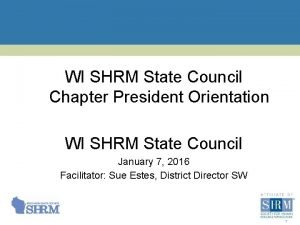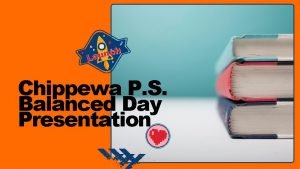Story Troves at the Chippewa Valley Aphasia Camp

- Slides: 1

Story Troves at the Chippewa Valley Aphasia Camp: Using Artifacts to Jointly Construct and Scaffold Contributions of Individuals with Aphasia Shannon Riley, Ashley O’Connell, Jerry Hoepner, Ph. D. , CCC-SLP, Tom Sather, Ph. D. , CCC-SLP Communication Sciences and Disorders, University of Wisconsin – Eau Claire Camper Surveys Background Aphasia Camp 2016 • Participation-based weekend for adults with aphasia and families Story Troves is an interactive activity • Thematic troves used to collaboratively create a story Past research: • Task characteristics: Awareness of Aphasia, Opportunity for Participation, Familiarity , Availability of Extra Support for Communication, Communication Complexity, and Time were shown to effect participation for PWA (Howe, Worrall & Hickson, 2008) • Narrative discourse: Narrative structure can be used to bridge words and sentences to real life communication (Whitworth, 2010) • Story immersion: Stories empower people with aphasia to focus on the flow of ideas rather than the relevance for communication and comprehension. Imagination evokes language (Stapleton, Whiteside, Davies, Mott, Chambel, Thomas, 2014) +Photos Aphasia Friendliness • Complexity: “One camper said: “I have trouble with numbers” as he tried to say a date from the story trove. ” Fostering Language and Communication: “I do think that it made for more conversation” Challenges: “That was a little difficult. My husband was unable to follow along” Changes Across Time • Unveiling • Initial Exploration • Parallel Exploration • Final Exploration Dislike: “Too much Capone time” Positive Remarks: “Got aphasia campers thinking more” Set Up: “It was returned to enough times throughout” Methods Qualitative data was obtained through four measures 1. Field notes (54) and photographs (16) 2. Student volunteer focus group responses (39) 3. Staff surveys (35) 4. Camper surveys (10) • Each Source was analyzed • Open axial coding process was utilized for each source • Two-three rounds of consensus coding • One of the rounds of coding was completed by arranging cut-out utterances according to categories • Overarching themes and specific categories were formed for each source Results Student Volunteer Focus Group • References • Howe, T. J. , Worrall, L. E. , & Hickson, L. H. (2008). Interviews with people with aphasia: Environmental factors that influence their community participation. Aphasiology, 22(10), 1092 -1120. doi: 10. 1080/0268703070164094 • Whitworth, A. (2010). Using narrative as a bridge: linking language processing models with real-life communication, Seminars In Speech & Language, 31(1), 64 -75 12 p. • Stapleton, Christopher, Whiteside Phd, Janet, Davies Phd, Jim, Mott, Dana, Vick, Jennifer, Chambel, Teresa, Thomas, Graham. (2014) Transforming Lives Through Story Immersion: Innovation of Aphasia Rehabilitation Therapy. through Storytelling Learning Landscapes. Immersive Media Experiences Proceedings of the 2 nd ACM International Workshop, 29 -34 Fostering Language and Communication: “The overall concept behind it was really good, it was getting them in an abstract way to communicate…” Frustration: “…it was like we were having this huge build up and then kind of a low presentation with no answer. ” Interest: “I thought it was really cool and I guess I thought it was worth it. ” Confusion/Linguistic Overload: “…and at least for me I could not keep all the characters straight. ” Negative Reactions: “One camper gave me thumbs down. ” Staff Surveys Caregivers Took Over: “…you could tell that the caregivers were super into it and like took over it. ” Conclusion and Implications Qualitative task analysis established what worked and what needed refinement • This constructive information will support future curricular planning and continuous improvement • Application of this feedback to future camp activity planning • Results from this study can be used in similar experiences to design and scaffold activities that foster success, interaction, and communication for those with aphasia • Consideration of the successes and challenges in this study is beneficial not only for camp settings, but also for future aphasia groups and activities • Successes and challenges derived from the study can be seen as barriers and facilitators as it relates to the WHO-ICF model Fostering Language and Communication • Camper Statements: “Camper stated: “There are too many clues!”” • Created Communication Opportunities: “Camper volunteered to speak into the microphone. ” • General Conversation: “There was heavy, continuous conversation that filled the room. ” • Supported Communication Participation • Engagement: “Campers getting up and looking at different tables’ clues. ” • Disengagement: “Eight people signed up for the session, only three attended. ” • Problem Solving • Joint: “People mingled asking questions to each other. ” • Individual: “Camper trying to identify people in the picture. ” Complexity: “…there were so many things going on that I could not follow it…” Aphasia friendliness: “Students did a great job helping the participants during small groups. ” • Speed: “That Saturday afternoon session where people created their stories was NOT aphasia friendly. Too fast…” Complexity: “Too much information being thrown at people at once. ” Ambiguity: “I also feel like a lot of people wanted an answer to the story and that was very frustrating. ” Fostering language and communication: “It seemed authentic and fostered a lot of curiosity and questions…” Scaffolding Challenges: “And the people with aphasia kept saying it was really hard to follow and just really confusing. ” Engagement: “Several campers with aphasia were pretty engaged…” • Hands on: “Campers loved the items, getting their hands on them, exploring…” Disengagement: “…even those who did sign up for it and still went didn’t get into it I guess, they just sat there. ” Positive Reactions: “Very interesting and well thought out. ” Initial Mutual Exploration: “…when Uncoded: “A little bit. ” everyone was in the big group, they were like okay everyone else is doing Time: “And then we only spent five this so why don’t I? And that’s when minutes explaining each of our stories…” people got into the hands-on stuff” Disengagement: “The younger ones lost interest fast. ” Ambiguity: “Having an anything is possible story is just hard. ” Creativity/Planning: “The development and creativity were amazing. ” • Al Capone Theme: “Many of the campers thought there was really an Al Capone link to the camp…” • Props: “Incredible relics and actual items. ” • Execution of plan: “Facilitating the telling of each small group’s individual story was not effective, partly because the plan continued to change and much because it was so rushed. ” General Interest: “I found that the older campers (people with aphasia) were very interested. ” Time • Too long: “Maybe a bit drawn out. Many campers lost interest by the third day…” • Time allocation/distribution: “Needed more time to develop a story- that got rushed at the end in the Saturday afternoon event. ” Acknowledgements The authors wish to thank UWEC Office of Research and Sponsored Programs (ORSP) and Learning and Technology Services (LTS) as well as the Aphasia Camp participants.

